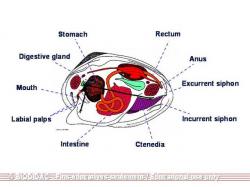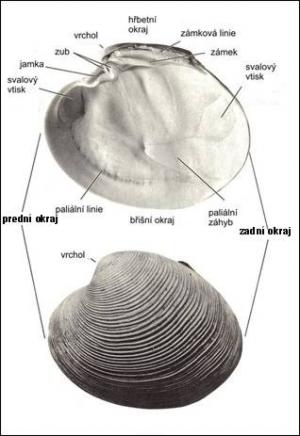Bivalves (Bivalvia)
Bivalves occupy marine, brackish and fresh water environments. The calcareous and /or aragonite shell formed by two valves is covered and protected by a thin outer organic layer, the periostracum. At the umbos the valves are connected by an organic ligament and by interior hinge teeth and sockets. A plane of symmetry passes between the valves. The shell surface has various sculptures, like radial ribs, and growth wrinkles or furrows. The interior of the shell is commonly nacreous. Soft parts include a prominent foot, the mantle which secretes the shell, gills and a visceral sac containing digestive and other organs. The adductor muscles between valves serve to close the shell, while pedal muscles control the protracting and retracting of the muscular foot for burrowing in the sediment, and fix the visceral sac. Bivalves are microphagous animals, i.e. feeding on microscopic particles, and hence lack the characteristic radula of other classes of molluscs. The oldest and primitive bivalves feed on organic particles among muddy and sandy sediments. Other bivalves are suspension feeders and other filter feeders. The classification of bivalves is complex and is based on gills, hinge, ligament, muscles and muscle scars on the shell, and other features. The shell grows by accretion at the valve margins, and represents the ontogenetic development of the individual from the earliest stages of the shell to the adult. Using the functional morphology the shell in Recent bivalves makes it possible to interpret modes of life in the majority of fossil bivalves, and thus their palaeoenvironment. Suspension and filter feeding bivalves need to be well fixed or anchored in the sediment where they can use the water current for filtering organic particles and micro-organisms at minimal energy cost. Bivalves burrow in the sediment, or bore into the wood or rocks, or may cement or attach to firm substrates with byssal threads. Evolutionarily the bivalves represent one of the most successful groups of benthic organisms. They first appeared in the Lower Cambrian, survived all periods of mass extinction through the Phanerozic, and gradually occupied the majority of niches in and on the bottom sediment. In the Recent they represent one of the most diversified classes of molluscs. In Bohemia, fossil bivalves are well represented in the Ordovician, Silurian and Devonian of the classic Barrandian Prague Basin, in the Moravian and Silesian Carboniferous, in the Bohemian Cretaceous Basin and in the Moravian marine Tertiary.
Author: Jiří Kříž | ||
Virtual museum of the Czech Geological Survey, www.geology.cz, (C) Czech Geological Survey, 2011, v.0.99 [13.12.2011]


![[ENG]](img/vlajka-cr.gif) Česky
Česky 

